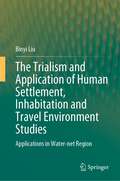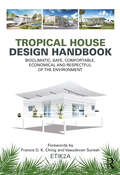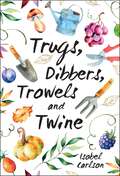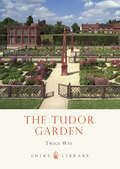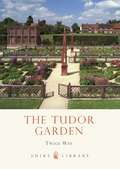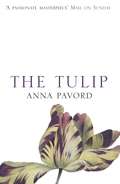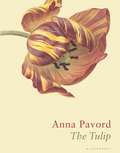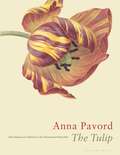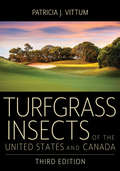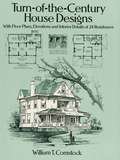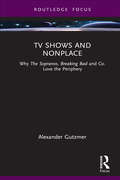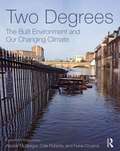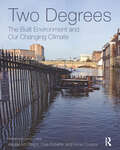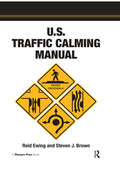- Table View
- List View
The Trialism and Application of Human Settlement, Inhabitation and Travel Environment Studies: Applications in Water-net Region
by Binyi LiuThis book studies human settlements in China in terms of Human Settlements Trialism in 5 typical human settlement types: river valleys, water networks, hills, plains, and arid areas. Focusing on 3 elements of Trialism—(1) natural and constructed environments, resources, and visual landscapes in human settlements background; (2) survival strategies, customs, culture, and values in human settlements activity; and (3) the layout of time and space as well as the planning and design of the urban, the country, and the wilderness in human settlements construction—the book analyzes the evolution of human settlements and predicts future trends. Presenting academic researchers and graduate students in various fields with insights from landscape architecture, urban planning, architecture, geography, forestry, art, and psychology, the study discusses the principles of interactive physiological thinking and systematically theoretical philosophy related to professional physiology, planning and design principles, and traditional and modern methods and technologies in urban and rural construction. The innovative multi-discipline study promotes the planning and design of 5 types of human settlement, which is helpful to the judgment of value, activity rule, and living style of human settlements, and also discusses the development of human settlements in the new millennium.
The Triumph of Seeds: How Grains, Nuts, Kernels, Pulses, and Pips Conquered the Plant Kingdom and Shaped Human History
by Thor HansonAs seen on PBS's American Spring LIVE, the award-winning author of Buzz and Feathers presents a natural and human history of seeds, the marvels of the plant kingdom"The genius of Hanson's fascinating, inspiring, and entertaining book stems from the fact that it is not about how all kinds of things grow from seeds; it is about the seeds themselves." --Mark Kurlansky, New York Times Book ReviewWe live in a world of seeds. From our morning toast to the cotton in our clothes, they are quite literally the stuff and staff of life: supporting diets, economies, and civilizations around the globe. Just as the search for nutmeg and pepper drove the Age of Discovery, coffee beans fueled the Enlightenment and cottonseed sparked the Industrial Revolution. Seeds are fundamental objects of beauty, evolutionary wonders, and simple fascinations. Yet, despite their importance, seeds are often seen as commonplace, their extraordinary natural and human histories overlooked. Thanks to this stunning new book, they can be overlooked no more. This is a book of knowledge, adventure, and wonder, spun by an award-winning writer with both the charm of a fireside story-teller and the hard-won expertise of a field biologist. A fascinating scientific adventure, it is essential reading for anyone who loves to see a plant grow.
Tropical House Design Handbook: Bioclimatic, Safe, Comfortable, Economical and Respectful of the Environment
by Etik2aPacked with accessible information, this book covers all the technical and practical aspects of home design in tropical environments. . It begins by outlining the prerequisites needed to understand the issues involved (climate, heat, thermal comfort, etc.) and discusses the solutions offered by traditional housing. It then identifies current solutions for protecting buildings and their occupants from solar radiation and external heat, while promoting bioclimatic and environmentally friendly approaches. . The economic viability of the solutions identified is discussed, as are the advantages and disadvantages of the materials, depending on the context and standards in force. . Numerous examples illustrate how buildings can be adapted to local realities, from the avant-garde creations of Jean Prouvé to those of today’s architects who are committed to sustainable development, as well as specific projects incorporating the recommendations made in this book. More than 460 photos, drawings, diagrams, tables, maps, house plans, logos and pictograms illustrate this reference work for all those involved in construction in tropical regions, particularly students in the field and, more generally, anyone – from professionals to private individuals – looking for useful information on this subject.
Tropical House Design Handbook: Bioclimatic, Safe, Comfortable, Economical and Respectful of the Environment
by Etik2aPacked with accessible information, this book covers all the technical and practical aspects of home design in tropical environments. . It begins by outlining the prerequisites needed to understand the issues involved (climate, heat, thermal comfort, etc.) and discusses the solutions offered by traditional housing. It then identifies current solutions for protecting buildings and their occupants from solar radiation and external heat, while promoting bioclimatic and environmentally friendly approaches. . The economic viability of the solutions identified is discussed, as are the advantages and disadvantages of the materials, depending on the context and standards in force. . Numerous examples illustrate how buildings can be adapted to local realities, from the avant-garde creations of Jean Prouvé to those of today’s architects who are committed to sustainable development, as well as specific projects incorporating the recommendations made in this book. More than 460 photos, drawings, diagrams, tables, maps, house plans, logos and pictograms illustrate this reference work for all those involved in construction in tropical regions, particularly students in the field and, more generally, anyone – from professionals to private individuals – looking for useful information on this subject.
Trowel and Error: Over 700 Organic Remedies, Shortcuts, and Tips for the Gardener
by Sharon LovejoyEver since she was old enough to help her grandmother in the garden, Sharon Lovejoy has spent her life working with plants--and along the way, through "trowel and error," she's accumulated hundreds and hundreds of remedies, tips, short-cuts, and cure-alls. Now Ms. Lovejoy--author of Roots, Shoots, Buckets & Boots and the award-winning Sunflower Houses--does for the garden what Heloise or the Queen of Clean does for the household. Trowel and Error collects all of her homespun garden advice into an inviting, environmentally friendly, whimsically illustrated yet dead-on helpful book that will benefit every gardener, beginner or experienced.Cure plant viruses with spoiled milk. Steep a natural and effective insecticide out of fresh basil. Place flat stones under squash or melons to hasten ripening. Recycle an old apple corer as the perfect dibber for muscari and other small bulbs. Start rosemary cuttings in a green glass bottle. Sprinkle baby powder over seedlings to discourage rabbits. Crush a garlic clove and apply it to your skin as an insect repellent. From urging the reader to take an occasional shower with the houseplants to giving all-natural gardenside first aid, Trowel and Error is a direct line to the kind of practical wisdom that comes only after a lifetime of experience. The book is indexed by problem, plant, pest, and solution, and includes a list of tools and common household items--borax, cornmeal, vinegar--that completes the gardener's arsenal.
True Urbanism: Living In and Near the Center
by Mark HinshawMark Hinshaw has a proposition for Americans: Come out of the bunker, throw open the gates, and meet the neighborhood. In this passionate appeal, he introduces those who have already done just that and explains what cities can do to make true urbanism possible. He rejoices in the growing number of people rejecting sterile, paint-by-numbers subdivisions in favor of vibrant and unpredictable urban neighborhoods. This vivid account of cities small and large emerging from the cobwebs of late 20th century development will show communities with lingering antiurban tendencies how to embrace density as destiny. A must-read urban design book for anyone who cares about cities.
True Urbanism: Living In and Near the Center
by Mark HinshawMark Hinshaw has a proposition for Americans: Come out of the bunker, throw open the gates, and meet the neighborhood. In this passionate appeal, he introduces those who have already done just that and explains what cities can do to make true urbanism possible. He rejoices in the growing number of people rejecting sterile, paint-by-numbers subdivisions in favor of vibrant and unpredictable urban neighborhoods. This vivid account of cities small and large emerging from the cobwebs of late 20th century development will show communities with lingering antiurban tendencies how to embrace density as destiny. A must-read urban design book for anyone who cares about cities.
Trugs, Dibbers, Trowels and Twine: Gardening Tips, Words of Wisdom and Inspiration on the Simplest of Pleasures
by Isobel CarlsonFollow the garden path to horticultural heaven with this compendium of blossoming inspiration and tips for making your garden grow. Learn about banning bugs and slugs and attracting beneficial creatures, recycling your old household items for gardening solutions – and why you should always keep a leek in your attic.
The Tudor Garden: 1485–1603 (Shire Library)
by Twigs WayContrived, colourful and cultured, the Tudor garden was a paradise on earth, given over to pleasurable pastimes and aesthetic effect. Artificiality was the fashion of the age, with clipped and twining plants vying for space with brightly painted woodwork and patterned beds.Renaissance discoveries reared their heads in royal gardens, where gilded and painted heraldic figures mingled with fantastical sundials and glittering fountains. Walls kept out the wild world beyond, while mounts afforded glimpses to new parklands and provided raised platforms for the banqueting houses of the wealthy. Ever-changing with newly introduced exotic plants, yet featuring year-round knot gardens, the Tudor garden was a vibrant pageant, and is given a suitably colourful celebration in this fully illustrated book.
The Tudor Garden: 1485–1603 (Shire Library #720)
by Twigs WayContrived, colourful and cultured, the Tudor garden was a paradise on earth, given over to pleasurable pastimes and aesthetic effect. Artificiality was the fashion of the age, with clipped and twining plants vying for space with brightly painted woodwork and patterned beds.Renaissance discoveries reared their heads in royal gardens, where gilded and painted heraldic figures mingled with fantastical sundials and glittering fountains. Walls kept out the wild world beyond, while mounts afforded glimpses to new parklands and provided raised platforms for the banqueting houses of the wealthy. Ever-changing with newly introduced exotic plants, yet featuring year-round knot gardens, the Tudor garden was a vibrant pageant, and is given a suitably colourful celebration in this fully illustrated book.
The Tulip: Twentieth Anniversary Edition
by Anna PavordTHE TULIP is not a gardening book. It is the story of a flower that has made men mad. Greed, desire, anguish and devotion have all played their part in the development of the tulip into the world-wide phenomenon it is today. No other flower has ever carried so much cultural baggage; it charts political upheavals, illuminates social behaviour, mirrors economic booms and busts, plots the ebb and flow of religious persecution. Pavord tells how the tulip arrived from Turkey and took the whole of Western Europe by storm. Sumptuously illustrated from a wide range of sources, this beautifully produced and irresistible volume will become a bible, a unique source book, a universal gift book and a joy to all who possess it.
The Tulip: The Story of the Flower that Has Made Men Mad
by Anna PavordAnna Pavord's now classic, internationally bestselling sensation, The Tulip, is not a gardening book. It is the story of a flower that has driven men mad. Greed, desire, anguish and devotion have all played their part in the development of the tulip from a wild flower of the Asian steppes to the worldwide phenomenon it is today. No other flower carries so much baggage; it charts political upheavals, illuminates social behaviour, mirrors economic booms and busts, plots the ebb and flow of religious persecution.
The Tulip: Twentieth Anniversary Edition
by Anna PavordA twentieth anniversary edition of the classic, featuring new material by the author. Anna Pavord's internationally bestselling sensation, The Tulip, is the story of a flower that has driven men mad. Greed, desire, anguish, and devotion have all played their part in the development of the tulip into a worldwide phenomenon. Today, the United States alone imports three thousand million tulip bulbs each year. No other flower has ever carried so much consequence; it charts political upheavals, illuminates social behavior, mirrors economic booms and busts, plots the ebb and flow of religious persecution. Why did the tulip dominate so many lives through so many centuries in so many countries? Anna Pavord, a self-confessed tulipomaniac, spent six years looking for answers, roaming through Asia, India, and the Ottoman Empire to tell how a humble wildflower of the Asian steppes made its way to Turkey and from there took the whole of Western Europe by storm. Sumptuously illustrated from a wide range of sources, this irresistible volume has become a bible, a unique source book, a universal gift book, and a joy to all who possess it. This beautifully redesigned edition features a new Preface by the author, a completely revised listing of the best varieties of this incomparable flower to choose for your garden, and a reorganized listing of tulip species, to reflect the latest thinking by taxonomists.
Turfgrass Insects of the United States and Canada
by Patricia J. VittumThe first edition of this reference work became known as the bible of turfgrass entomology upon publication in 1987. It has proved invaluable to professional entomologists, commercial turf managers, and golf course superintendents and has been used widely in college extension courses. This classic of the field is now in its third edition, providing up-to-date and complete coverage of turfgrass pests in the continental United States, Hawaii, and southern Canada.This revised volume integrates all relevant research from the previous two decades. It provides expanded coverage of several pest species, including the annual bluegrass weevil, invasive crane fly species, chinch bugs, billbugs, mole crickets, and white grubs. Patricia J. Vittum also provides detailed information on the biology and ecology of all major pests and includes the most current information on conditions that favor insect development and biological control strategies pertinent to each species.This edition will include more than 100 black-and-white images, including diagrams of life cycles, sketches of morphological characteristics, and charts highlighting seasonal activity. The book also includes 72 full-color plates (more than 500 color images), showing closeup pictures of most of the key insects (adult and immature stages) and damaged turf. The reader should be able to identify most turf insects through the use of this text. It is a critical reference work that any serious turf professional should own.
Turn-of-the-Century House Designs: With Floor Plans, Elevations and Interior Details of 24 Residences
by William T. ComstockThis inexpensive archive of handsome turn-of-the-century designs reprinted directly from a rare late Victorian volume contains plans for a variety of suburban and country homes that are both aesthetically appealing and moderate in cost. Included are plans for 24 cottages and houses in a wide range of styles, among them Queen Anne, Eastlake, and Colonial. Over 130 illustrations — floor plans, elevations, perspective views, and more — enhance the text, which is further supplemented by two informative and useful articles: "Suggestions on House Building," by A. W. Cobb, describes the process of building a home, from the first sketches offered by the architect to his client, to property selection, scale drawings, and details of construction. “How to Plumb a Suburban House,” by Leonard D. Hosford, provided the late Victorian era homeowner with valuable advice about sewage disposal.Restorers of old houses, preservationists, and students of American architectural history will welcome this treasury of authentic century-old plans and details. Students of social history will also find it an excellent reference.
TV Shows and Nonplace: Why The Sopranos, Breaking Bad and Co. Love the Periphery (Routledge Focus on Television Studies)
by Alexander GutzmerThis book scrutinizes the relationship between contemporary TV shows and space, focusing on the ways in which these shows use and narrate specific spatial structures, namely, spaces far away from traditional metropolises. Beginning with the observation that many shows are set in specific spatial settings, referred to in the book as “nonplace territories” – e.g., North Jersey, New Mexico, or rural and suburban Western Germany – the author argues that the link between such nonplace territories and shows such as The Sopranos, Breaking Bad, or Dark is so intense because the narrative structure functions similarly to these territories: flat, decentralized, without any sense of structure or stable hierarchy. The book takes three different perspectives: first, it looks at the rationale for combining TV shows and nonplace territories from the viewpoint of narrative strategy. It then thinks through what these strategies mean for practicing architects. Finally, it approaches the arguments made before from a “user” perspective: what does this narrative mirroring of social-spatial reality in places such as Albuquerque or Jersey City mean for people living in these places? This new approach to architecture and space on screen will interest scholars and students of television studies, screen architecture, media and architectural theory, and popular culture.
TV Shows and Nonplace: Why The Sopranos, Breaking Bad and Co. Love the Periphery (Routledge Focus on Television Studies)
by Alexander GutzmerThis book scrutinizes the relationship between contemporary TV shows and space, focusing on the ways in which these shows use and narrate specific spatial structures, namely, spaces far away from traditional metropolises. Beginning with the observation that many shows are set in specific spatial settings, referred to in the book as “nonplace territories” – e.g., North Jersey, New Mexico, or rural and suburban Western Germany – the author argues that the link between such nonplace territories and shows such as The Sopranos, Breaking Bad, or Dark is so intense because the narrative structure functions similarly to these territories: flat, decentralized, without any sense of structure or stable hierarchy. The book takes three different perspectives: first, it looks at the rationale for combining TV shows and nonplace territories from the viewpoint of narrative strategy. It then thinks through what these strategies mean for practicing architects. Finally, it approaches the arguments made before from a “user” perspective: what does this narrative mirroring of social-spatial reality in places such as Albuquerque or Jersey City mean for people living in these places? This new approach to architecture and space on screen will interest scholars and students of television studies, screen architecture, media and architectural theory, and popular culture.
Twenty-First Century Urbanism: A New Analysis of the City
by Rob SullivanThis volume argues that the city cannot be captured by any one mode of analysis but instead is composed of the mobile, relational, efficient, sentient, and the phenomenological with all of them cast in new theoretical configurations and combined into one methodological entity. Rather than focusing on any one city or abstract analytical model, this book instead takes a multipronged theoretical and methodological approach to present the city as an intelligent affective organism – a sentient being. It proposes that cities operate on a relational, mobile, and phenomenological basis through the mode of efficiency, calibrated by a profoundly complicated division of labor. Its starting point is that the city is a mobile unit of analysis, from its economic status to its demographic makeup, from its cultural configuration to its environmental conditions, and therefore easily evades our quantitative and qualitative methods of computation and comprehension. Twenty-First Century Urbanism provides planning and urban design academics and students with a multifaceted approach to understanding the development of cities, encouraging the examination of cities through a myriad, non-linear approach.
Twenty-First Century Urbanism: A New Analysis of the City
by Rob SullivanThis volume argues that the city cannot be captured by any one mode of analysis but instead is composed of the mobile, relational, efficient, sentient, and the phenomenological with all of them cast in new theoretical configurations and combined into one methodological entity. Rather than focusing on any one city or abstract analytical model, this book instead takes a multipronged theoretical and methodological approach to present the city as an intelligent affective organism – a sentient being. It proposes that cities operate on a relational, mobile, and phenomenological basis through the mode of efficiency, calibrated by a profoundly complicated division of labor. Its starting point is that the city is a mobile unit of analysis, from its economic status to its demographic makeup, from its cultural configuration to its environmental conditions, and therefore easily evades our quantitative and qualitative methods of computation and comprehension. Twenty-First Century Urbanism provides planning and urban design academics and students with a multifaceted approach to understanding the development of cities, encouraging the examination of cities through a myriad, non-linear approach.
The Twilight Garden: A Guide To Enjoying Your Garden In The Evening Hours
by Lia LeendertzSome say that the twilight hours are the best time to enjoy a garden; a time when the spirit of the place really comes alive. It is also the time when many people pass front gardens on their return home, have a few spare minutes for garden maintenance, or want to enjoy the garden for entertaining. Full of easy maintenance advice, planting ideas for evening fragrance, colour, lighting, design, and attracting wildlife, this is a book for how people garden now. Front gardens, terraces, larger plots and containers will all be covered in an attempt to inspire everyone to transform their outdoor space into a twilight paradise.
Two Degrees: The Built Environment And Our Changing Climate
by Alisdair McGregor Cole Roberts Fiona CousinsThe Earth’s temperature has been rising. To limit catastrophic outcomes, the international scientific community has set a challenging goal of no more than two degrees Celsius (3.6 degrees Fahrenheit) average temperature rise. Economists agree we will save trillions of dollars by acting early. But how do we act successfully? And what’s the backup plan if we fall short? Setting politics aside, Two Degrees reviews the current science and explains how we can set practical steps to reduce the extent of warming and to adapt to the inevitable changes, all while improving the bottom line, beautifying our communities, and increasing human health. The book is a practical guide intended for a broad audience of those who occupy and shape our built environment. The authors provide a clear framework for communities, policy makers, planners, designers, developers, builders, and operators to help manage the impacts and capture the opportunities of our changing climate. Two Degrees is divided into three sections—Fundamentals, Mitigation, and Adaptation—covering a diverse array of topics ranging from climate-positive communities and low-carbon buildings to the psychology of choice and the cost of a low-carbon economy. After a foreword by Amory Lovins, more than 10 contributing authors share knowledge based on direct experience in all aspects of built environment practice. This book clarifies the misconceptions, provides new and unique insights, and shows how a better approach to the built environment can increase resilience and positively shape our future.
Two Degrees: The Built Environment And Our Changing Climate
by Alisdair McGregor Cole Roberts Fiona CousinsThe Earth’s temperature has been rising. To limit catastrophic outcomes, the international scientific community has set a challenging goal of no more than two degrees Celsius (3.6 degrees Fahrenheit) average temperature rise. Economists agree we will save trillions of dollars by acting early. But how do we act successfully? And what’s the backup plan if we fall short? Setting politics aside, Two Degrees reviews the current science and explains how we can set practical steps to reduce the extent of warming and to adapt to the inevitable changes, all while improving the bottom line, beautifying our communities, and increasing human health. The book is a practical guide intended for a broad audience of those who occupy and shape our built environment. The authors provide a clear framework for communities, policy makers, planners, designers, developers, builders, and operators to help manage the impacts and capture the opportunities of our changing climate. Two Degrees is divided into three sections—Fundamentals, Mitigation, and Adaptation—covering a diverse array of topics ranging from climate-positive communities and low-carbon buildings to the psychology of choice and the cost of a low-carbon economy. After a foreword by Amory Lovins, more than 10 contributing authors share knowledge based on direct experience in all aspects of built environment practice. This book clarifies the misconceptions, provides new and unique insights, and shows how a better approach to the built environment can increase resilience and positively shape our future.
U.S. Traffic Calming Manual
by Reid EwingA comprehensive how-to manual for traffic calming in the United States. Planners and engineers can look to this manual for guidance on the appropriate use, design, and signing and marking of traffic-calming measures. For local officials, developers, and community associations, it is an introduction to the goals and tactics of traffic calming. Based in part on the first traffic-calming manual taken through a formal rule-making process and adopted by a state department of transportation as a supplement to its roadway design manual, this book catalogs principles that have been modified by many local jurisdictions to match local priorities and preferences. Standardization is key to the success of traffic-calming initiatives, and this book explains the processes, tools, and design needed to create a standard traffic-calming program. It also shows how municipalities can build needed flexibility into such programs. Signage and markings are also key, and a chapter is devoted to these issues. This is the book that states and municipalities need to create effective traffic-calming programs.
U.S. Traffic Calming Manual
by Reid EwingA comprehensive how-to manual for traffic calming in the United States. Planners and engineers can look to this manual for guidance on the appropriate use, design, and signing and marking of traffic-calming measures. For local officials, developers, and community associations, it is an introduction to the goals and tactics of traffic calming. Based in part on the first traffic-calming manual taken through a formal rule-making process and adopted by a state department of transportation as a supplement to its roadway design manual, this book catalogs principles that have been modified by many local jurisdictions to match local priorities and preferences. Standardization is key to the success of traffic-calming initiatives, and this book explains the processes, tools, and design needed to create a standard traffic-calming program. It also shows how municipalities can build needed flexibility into such programs. Signage and markings are also key, and a chapter is devoted to these issues. This is the book that states and municipalities need to create effective traffic-calming programs.
